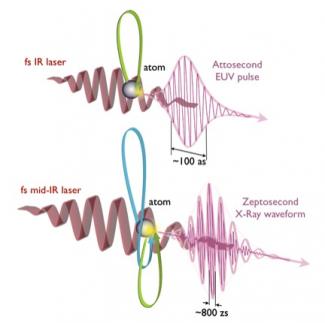Many people are familiar with the beautiful harmonies created when two sound waves interfere with each other, producing a periodic and repeating pattern that is music to our ears. In a similar fashion, two interfering x-ray waves may soon make it possible to create the fastest possible strobe light ever made. This strobe light will blink fast enough to allow researchers to study the nuclei of atoms and other incredibly tiny structures. The new strobe light is actually very fast coherent laser-like radiation created by the interference of high-energy x-ray waves.
The theory predicting this advance was developed by research associate Carlos Hernández-García; senior research associates Agnieszka Jaron-Becker and Tenio Popmintchev; Fellows Andreas Becker, Margaret Murnane, and Henry Kapteyn, and their colleagues from the Universidad de Salamanca and El Centro de Láseres Pulsados, both in Salamanca, Spain.
The theory says that a mid-infrared a laser would be able to accelerate an electron away from its parent atom, then crash the electron back into the atom, not once but many times. Every time the electron crashed back into the parent atom, it could emit coherent bursts of x-rays, in a process known as high harmonic generation. Moreover, each half-cycle of the mid-infrared laser field could accelerate a different part of the electron cloud. The interference of different x-ray bursts would then produce pulses of coherent radiation hundreds of zeptoseconds (10-19 s) long. For comparison, the shortest laser pulse lengths that can be produced right now are about a thousand times wider: 100 attoseconds, or 10-16 s.
“We already knew how to generate high harmonics of a laser that span into the x-ray regime. But, now we’re proposing to manipulate these x-rays to design light pulses at the shortest time scales,” explains Fellow Andreas Becker.
High-harmonic generation is already used in the Kapteyn/Murnane labs to make wide swathes of coherent ultraviolet-to-soft x-ray radiation from near-infrared coherent laser light. Now Hernandez-Garcia and his colleagues have figured out how to use a mid-infrared laser to control the behavior of an electron during high-harmonic generation so that two (or more) x-ray bursts interfere to produce the fastest strobe light ever, i.e., coherent zeptosecond laser-like radiation.
There are two key ingredients to bringing the new theoretical vision into reality: (1) Extending current mid-infrared lasers towards even longer wavelengths, a process that could take 5–10 years; and then (2) Using the longer-wavelength laser field to make it possible for electron waves emitted at different times to recombine at the same time and produce the desired interference of x-ray bursts
The good news is that Fellows Kapteyn and Murnane agree that producing shorter and shorter wavelength coherent radiation in the laboratory is an important goal. Achieving this goal may enable new and better medical imaging in the not-too-distant the future. As soon as the mid-infrared-laser technology is developed, the creation of coherent zeptosecond laser radiation will be just a matter of exquisitely controlling the interference of x-ray bursts, according to Becker.
The new laser theory was reported online July 18 in Physical Review Letters and highlighted in Nature and on the American Physical Society website. — Julie Phillips




